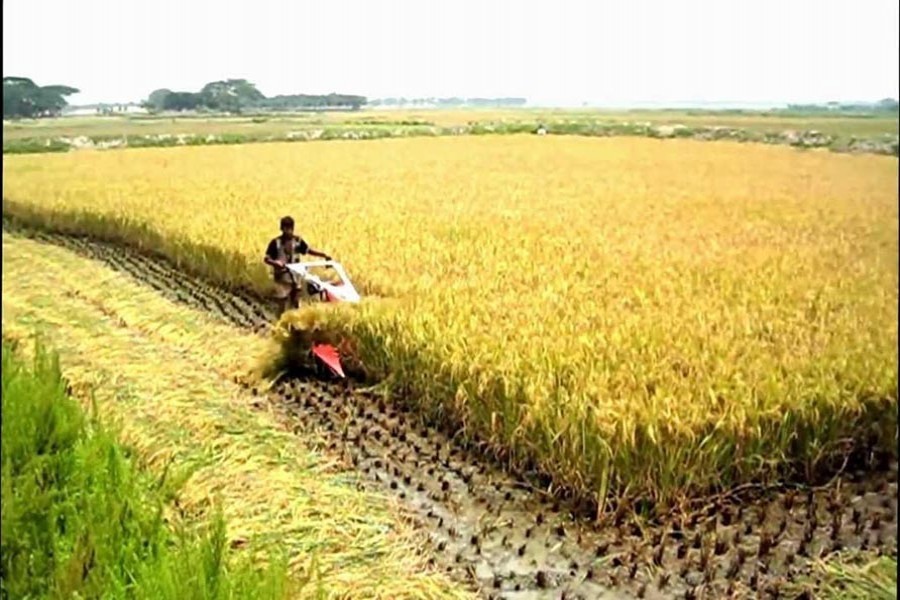For the past four decades or more, Bangladesh's agriculture policies have evolved in response to changing needs of time. Immediately after independence, policies were formulated keeping in view the strategic role of the public sector. It was a time when the public sector was involved in production and marketing of pin to plane of agriculture.
Unfortunately, the heavy engagement of the public sector in production, marketing, and distribution, allegedly, did little good to the economy; rather it gave rise to inefficiency and rent-seeking practices.
However, the monopoly of the state parastatals did not last long; the agriculture sector policies have opened the door for private sector investments and the sector did successfully come out of the grip of the public sector.
The green revolution in rice cultivation was initiated in the late 1960s with heavy public sector investment in procurement and distribution of modern agricultural inputs, and investment for flood control, drainage and irrigation.
The Bangladesh Agriculture Development Corporation (BADC), a parastatal organisation, established complete monopoly over procurement and marketing of fertilizers, small-scale agricultural equipment, and production and marketing of improved varieties of seeds. Another parastatal, the Bangladesh Water Development Board, was established to implement large-scale water resource development projects. During the 1960s and 1970s nearly a half of the public sector agriculture development budget was allocated for operations of these two parastatal organisations.
Chemical fertilizers were marketed with heavy subsidies in order to promote an unfamiliar input among farmers. It is estimated that for urea the rate of subsidy was 58 per cent in 1968/69 and 52 per cent in 1976. With increase in sales of fertilizers, the subsidy began to put a heavy burden on the government exchequer. By mid-1970s fertiliser subsidy accounted for a third of the public sector agriculture development budget.
Since the BADC controlled the marketing of fertilisers, supply of fertiliser became dependent on the amount of subsidy the government could afford. The period was characterised by frequent scarcity in the fertiliser market that gave impetus to political interference in the distribution process leading to rent-seeking and higher cost to farmers. The market distributed the scarce supply to those who could afford to pay high prices.
The government started deregulating the fertiliser market and phasing out fertiliser subsidies since the late 1970s. By the late 1980s, the rate of subsidy was eliminated for urea that is mostly domestically produced, and was reduced to 30 and 27 per cent respectively for phosphate and potash, which are mostly imported. The subsidy on imported fertilisers was eliminated from December 1992 with removal of ban on private sector import of fertilisers.
Since then the prices of phosphate and potash in the domestic market have been moving in line with those in the world market. The government, however, still controls the price of urea, which is produced in factories operated under the public sector.
The withdrawal of subsidies from chemical fertilisers has increased the actual cost of fertilisers at farmers' level particularly for phosphate and potash. But for high profitability in the cultivation of modern varieties (MVs) compared to traditional varieties (TVs), the increase in price did not depress the demand significantly. Indeed total fertiliser consumption continued to grow till the mid-1990s, although the level of consumption in terms of varieties has declined somewhat in the 1990s.
A positive effect of the withdrawal of subsidy is that fertiliser is now freely available. A free and highly competitive market for fertiliser ensures that farmers do not face scarcity during periods of rapid expansion of area under fertiliser-intensive MVs.
The government's earliest approach to expansion of irrigation facilities was through construction of multi-purpose flood-control, drainage and irrigation projects. They have been successful in protecting coastal and river belt areas from flooding and saline water intrusion but have played a minor role in irrigation development. Rapid expansion of irrigation began in the early 1980s with promotion under the private sector of small capacity shallow tube wells for ground water irrigation. Beginning in 1986, the government removed ban on private sector imports of agricultural equipment, abolished standardisation requirement imposed for quality control and easy availability of spare parts, and reduced import duties on farm machinery, which led to a substantial reduction in the cost of tube wells, and development of a market for irrigation services.
The liberalisation of the market for small-scale irrigation equipment contributed to a) mobilisation of private savings for investment in irrigation, b) elimination of delays in installing equipment and repair and maintenance that the farmers experienced earlier due to bureaucratic procedures and rent-seeking in the public sector, c) increased competition in the water market leading to a decline in water charges, and d) expansion in capacity utilisation of machines in years of favourable rice prices.
With unrestricted private sector import, farmers realised lower prices for minor irrigation equipment by identifying the low cost market and using plastic pipes in place of metal pipes for installation. By early 1989, the cost of installation of shallow tubewells fell by nearly 40 per cent. With reduction in prices, medium and small farmers did afford investment for irrigation that was financed mostly with own savings.
The change in policies contributed to rapid expansion in irrigation in the 1990s, use of optimal inputs, marketing of erstwhile subsistence crops especially of rice. However, time has come to focus on nutrition by using agriculture sector as a vehicle for nutritional improvements. Agriculture policies during this particular time of rapid per capita income growth should focus on nutritional value of food in the plate ensuring a fair distribution among economic classes.
Abdul Bayes is a former Professor of Economics at Jahangirnagar University and now an Adjunct Faculty at East West University.


